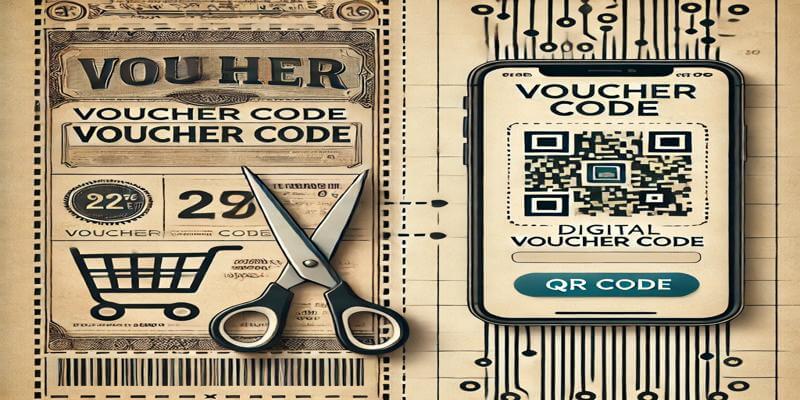The Evolution of Voucher Codes: From Paper Coupons to Digital Discounts
Voucher codes have transformed the shopping experience, evolving from simple paper coupons to sophisticated digital tools that drive modern e-commerce. Over time, they’ve adapted to consumer needs, technological advancements, and the rise of online shopping. Today, voucher codes offer convenience, accessibility, and innovative features like app-exclusive discounts and QR-based offers.

This article explores the fascinating history of voucher codes, their digital transformation, and the innovations shaping their future. From their humble beginnings to their pivotal role in modern retail, we’ll dive into how voucher codes became an indispensable part of our shopping habits.
The Beginnings: Paper Coupons
The Birth of Coupons
The concept of discounts began in 1887 when Coca-Cola distributed the first-ever coupon. Designed to encourage people to try their beverage, it offered a free glass of Coke to customers. This idea caught on quickly, with grocery stores and retail outlets embracing the strategy to attract local customers.
Expansion Through Print Media
By the mid-20th century, coupons became a household staple, appearing in newspapers, magazines, and direct mail. They were a simple yet effective way for brands to reach their audiences.
- Supermarket Boom: As supermarkets expanded in the 1950s and 1960s, coupons became a primary tool for promoting products.
- Localized Offers: Print coupons targeted regional audiences, helping local businesses drive foot traffic.
Challenges with Paper Coupons
Despite their popularity, paper coupons had limitations:
- Manual Validation: Clerks manually verified coupons, slowing down transactions.
- Limited Reach: Geographic restrictions meant that coupons could only serve local audiences.
- Fraud Risks: Counterfeit coupons and misuse posed challenges for retailers.
The Digital Revolution: Online Voucher Codes
The rise of the internet in the 1990s revolutionized how businesses reached customers. Voucher codes transitioned from paper to digital, unlocking a new era of savings.
The Rise of E-Commerce
The growth of e-commerce platforms like Amazon, eBay, and early online retailers introduced the concept of digital discounts. Promo code fields began appearing on checkout pages, making it easier for customers to apply savings.
- Convenience: Digital voucher codes eliminated the need for physical coupons, offering instant savings with a simple copy-and-paste action.
- Global Reach: Unlike paper coupons, digital codes could be used by customers worldwide.
The Convenience Factor
The digital transformation brought several advantages:
- Ease of Use: Shoppers could browse codes online and apply them at checkout.
- No Paper Waste: Digital codes contributed to eco-friendly shopping practices.
Impact of Online Marketplaces
Platforms like Amazon and eBay played a significant role in popularizing digital voucher codes. Affiliate websites dedicated to sourcing and sharing codes emerged, further streamlining the process. Customers no longer had to rely on direct mail or newspaper clippings—they could simply search online for the best deals.
Innovations in Digital Codes
As e-commerce advanced, so did the variety of voucher codes:
- Percentage Discounts: Offering savings like 20% off a total purchase.
- Free Shipping: Waiving delivery fees to encourage higher order values.
- Exclusive Offers: Codes tailored for specific audiences, such as students or first-time shoppers.
Modern Innovations in Voucher Codes
Today, voucher codes have evolved into a dynamic and integral part of marketing strategies, leveraging technology to create tailored and innovative experiences.
App-Exclusive Discounts
With the rise of mobile shopping, many brands offer app-only voucher codes to incentivize downloads and purchases through their apps.
- Examples:
- Uber: Promo codes for first rides.
- Deliveroo: Exclusive discounts for in-app orders.
- Amazon: A dedicated page for all the latest Amazon voucher codes
- Ebay: We have a huge selection of Ebay voucher codes
- Why It Works: Apps allow brands to engage directly with consumers, offering personalized promotions and building customer loyalty.
QR Code-Based Offers
QR codes are becoming increasingly popular for seamless in-store and online redemptions. Customers simply scan a code to unlock discounts or redeem offers.
- Real-World Uses:
- QR codes on product packaging leading to exclusive discounts.
- Scannable codes in advertisements, bridging offline marketing with online sales.
- Benefits: Quick, contactless transactions and reduced reliance on manual input.
Personalized Codes
Advances in AI have enabled brands to offer personalized voucher codes based on individual shopping habits.
- How It Works:
- Retailers analyze user data to send tailored discounts (e.g., 10% off your favorite product).
- These codes are often time-sensitive, creating a sense of urgency.
- Example: A frequent shopper at a clothing store might receive a personalized code for a category they often browse.
Limited-Time Flash Discounts
Retailers increasingly use time-sensitive codes to drive urgency and boost sales. These discounts often coincide with flash sales or product launches.
- Examples:
- “15% off for the next 2 hours.”
- Black Friday or Cyber Monday codes.
- Impact: Creates a “fear of missing out” (FOMO) effect, encouraging immediate purchases.
The Role of Voucher Codes in Modern E-Commerce
Voucher codes are no longer just a bonus—they’re a strategic tool that drives customer engagement and revenue.
Driving Customer Loyalty
Brands use exclusive codes to foster loyalty among existing customers. Loyalty programs often incorporate codes as rewards, offering discounts for repeat purchases.
- Example: Tesco Clubcard holders receive personalized discounts based on their shopping history.
Boosting Conversion Rates
Voucher codes significantly reduce cart abandonment rates. Customers who see discounts at checkout are more likely to complete their purchases.
- How It Works:
- Abandoned cart emails often include voucher codes to entice customers to return.
- For example: “Still interested? Here’s 10% off to complete your order.”
Social Media and Influencer Promotions
Social media platforms have become a hotspot for voucher code sharing, with influencers promoting exclusive codes to their followers.
- Example: Influencers sharing “10% off” codes for beauty products, driving sales while boosting brand visibility.
Sustainability Impact
Digital voucher codes align with the growing demand for sustainable shopping. By eliminating paper waste, they contribute to eco-friendly retail practices.
Challenges and Future Trends
Challenges with Digital Voucher Codes
Despite their success, digital voucher codes face certain challenges:
- Fraud: Misuse and counterfeit codes remain an issue for retailers.
- Overuse: Excessive discounts can devalue a brand, impacting profitability.
- Invalid Codes: Customers can become frustrated with codes that don’t work due to poor validation processes.
Future Trends in Voucher Codes
The future of voucher codes is shaped by technology and innovation:
- Blockchain-Based Voucher Systems: Secure and transparent, blockchain can prevent fraud and ensure traceability.
- Voice Commerce Discounts: As smart speakers like Alexa and Google Home grow in popularity, voice-activated voucher codes could become commonplace.
- Augmented Reality (AR) Discounts: AR technology could offer interactive discount experiences, such as scanning an AR object to unlock a code.
Conclusion
Voucher codes have come a long way from their beginnings as paper coupons, evolving into an essential part of modern retail. Their adaptability, convenience, and innovation continue to shape the way we shop, providing both savings for consumers and strategic advantages for brands. As technology advances, voucher codes will only become more personalized, seamless, and integrated into our shopping experiences.
Start exploring the latest digital voucher codes today at My Favourite Voucher Codes, where savings meet simplicity.
by Julian House 19th December 2024





